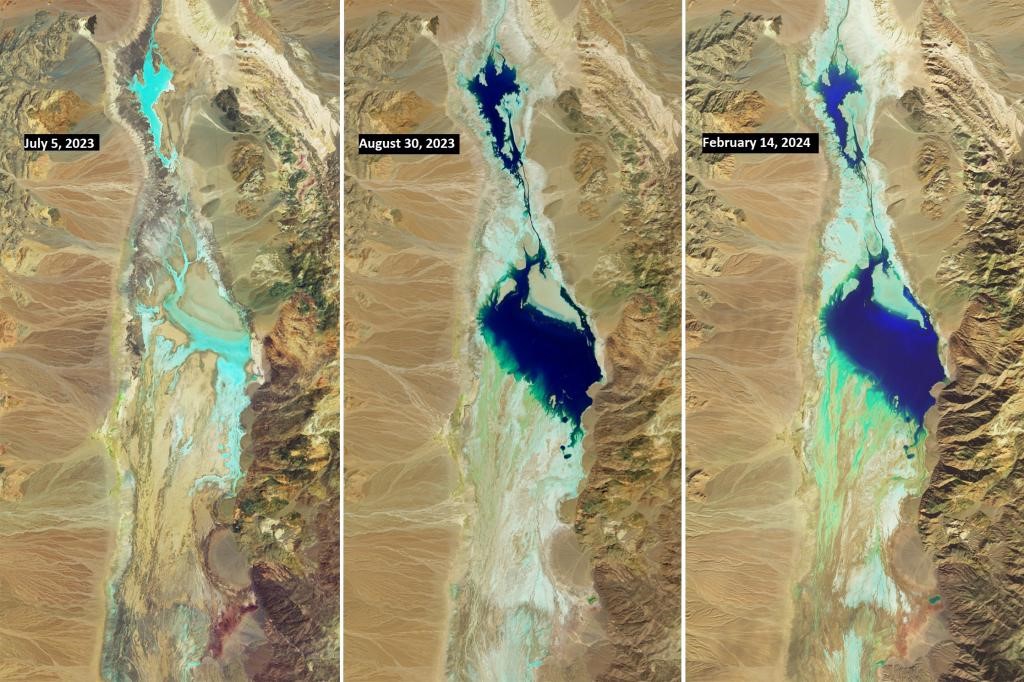Description

Disclaimer: Copyright infringement not intended.
Context
Badwater Basin in Death Valley received more than double its average annual precipitation since August 2023.
Details
- In the parched expanse of North America’s driest region, Badwater Basin, nestled within Death Valley, has defied expectations by lingering and expanding as an ephemeral lake.
- National Aeronautics and Space Administration (NASA) Earth Observatory has documented this phenomenon through satellite imagery, capturing the basin’s transformation before and after extreme weather events.
- Death Valley is well-known as the hottest place on Earth and the driest place in North America and is essentially a dry salt flat.
- Manly lake was formed in August 2023 after Hurricane Hilary. While the lake initially shrank as expected, it surprisingly persisted through the fall and winter months. Its resurgence came in February 2024, when a powerful atmospheric river replenished its waters.
- The lake now fills the low-lying salt flat, spanning several kilometres across. As of mid-February, the Manly lake remains.
- Badwater Basin’s endorheic nature means water flows into it but not out, typically resulting in rapid evaporation and ephemeral lakes. However, increased precipitation over the past six months has disrupted this pattern.
- Despite Death Valley’s average annual rainfall of only 51 millimetres, a remarkable 125 mm fell in the past half-year alone, primarily due to two significant weather events. The remnants of Hurricane Hilary deposited 55.88 mm precipitation on August 20, 2023, followed by an atmospheric river bringing another 38.1 mm from February 4-7, 2024.

Death Valley National Park
Location:
- Death Valley is situated in Eastern California, USA, and extends into Nevada. It is part of the Mojave Desert and covers an area of about 3,000 square miles (7,800 square kilometers).
Geography:
- Death Valley is known for its extreme landscapes, including salt flats, sand dunes, badlands, canyons, and mountains. It is home to the lowest point in North America, Badwater Basin, which sits at 282 feet (86 meters) below sea level. The park also features Telescope Peak, which rises to an elevation of 11,043 feet (3,366 meters).
Climate:
- Death Valley experiences a hot desert climate, with temperatures often soaring above 100°F (38°C) during the summer months. It holds the record for the highest reliably recorded air temperature on Earth, reaching 134°F (56.7°C) in July 1913 at Furnace Creek
Flora and Fauna:
- Despite its harsh conditions, Death Valley supports a variety of plant and animal life adapted to desert environments. Common plant species include creosote bush, desert holly, and various cacti. Wildlife such as bighorn sheep, coyotes, kit foxes, and various reptiles inhabit the park.
Human History:
- Death Valley has a rich cultural history, with evidence of human habitation dating back thousands of years. Native American tribes such as the Timbisha Shoshone have inhabited the region for centuries.
- The area gained notoriety during the California Gold Rush in the 19th century, and later became a national monument in 1933 before being designated as a national park in 1994.
Tourism:
- Despite its name and harsh environment, Death Valley attracts over a million visitors annually. Tourists come to explore its unique landscapes, engage in recreational activities such as hiking and photography, and learn about its natural and cultural heritage.

Conservation:
- Death Valley National Park is dedicated to preserving its unique ecosystems and cultural resources. Efforts are made to manage visitor impacts, conserve wildlife habitats, and promote sustainable practices within the park.
Challenges:
- The extreme conditions of Death Valley pose challenges for both visitors and wildlife. High temperatures, limited water sources, and rugged terrain require careful planning and preparation for those exploring the park. Conservation efforts also face challenges such as invasive species, climate change, and human impacts on the fragile desert ecosystem.
|
PRACTICE QUESTION
What is the lowest point in North America, located within Death Valley National Park?
- Dante's View
- Zabriskie Point
- Badwater Basin
- Mesquite Flat Sand Dunes
Answer C
|










